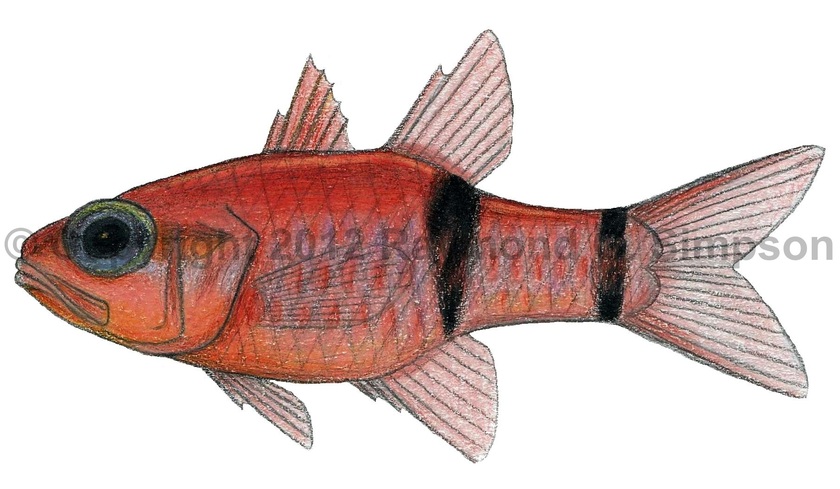
Common Name
Barred Cardinalfish
Year Described
Poey, 1867
Identification
Dorsal Fin: VI, I-9
Anal Fin: II, 8
Pelvic Fin: I, 5
Pectoral Fin: 12
Gill Rakers: 4-5 upper, 12-14 lower
Vertebrae: 10 precaudal, 14-15 caudal
A small fish with a fairly robust and moderately compressed body. Eye is large and the snout short. Mouth is fairly large and oblique, with the lower jaw slightly protruding. Both jaws, palatine, and vomer with bands of villiform teeth (no canines). Preopercular edge with a slightly serrate margin. Preopercular flap does not extend past the preopercular rear margin. There are two dorsal fins. The caudal fin is emarginate. Body scales ctenoid. Predorsal scales 6-7. Scales around the caudal peduncle 15-16.
Color
Body varies from very pale to bright translucent pinkish to red (can pale or darken base color). The lower side often has a blue opalescent sheen. The dorsal midline and eye often have a yellowish sheen. A thin dark band under the second dorsal fin runs to the anal fin base. Another dark band on the rear caudal peduncle is about the same width as the first band. A faint eye-stripe is often present. Fins are clear and unmarked.
Size
Maximum size to 100mm TL.
Habitat
Found in protected recesses on coral reefs from 1-60m.
Range
S. Florida to Venezuela, including the Gulf of Mexico and the Caribbean Sea.
References
Gon, O. 2002. Apogonidae (pp 1386-1391). In: Carpenter. 2002. The living marine resources of the Western Central Atlantic. Vol. 3: Bony fishes part 2 (Opistognathidae to Molidae), sea turtles and sea mammals. FAO Species Identification Guides for Fisheries Purposes. American Society of Ichthyologists and Herpetologists Special Publication No. 5.
McEachran, J.D. & J.D. Fechhelm. 2005. Fishes of the Gulf of Mexico. Volume 2: Scorpaeniformes to Tetraodontiformes. University of Texas Press, Austin. i-viii +1-1004.